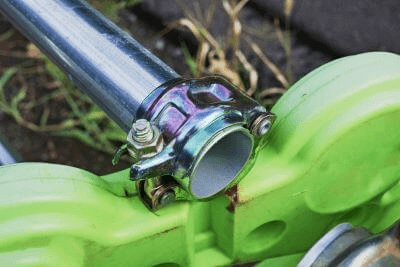What Is Chromate Treatment?
 Chromate treatment is a treatment method in which a chromate film is formed by passivation of the metal with a treatment solution containing hexavalent or trivalent chromium as its main component. Chromate treatment is usually applied to zinc-plated metals.
Chromate treatment is a treatment method in which a chromate film is formed by passivation of the metal with a treatment solution containing hexavalent or trivalent chromium as its main component. Chromate treatment is usually applied to zinc-plated metals.
Features of Chromate Treatment
Chromate film is characterized by its self-healing properties and superior corrosion resistance compared to other oxide films. It can also improve other properties, such as rust prevention, design, and electrical conductivity. In the past, hexavalent chromium was commonly used due to cost considerations, but since the use of hexavalent chromium is restricted in the EU, trivalent chromium is used as an alternative.
The self-healing properties of chromate treatment coatings are briefly explained as follows. When a defect occurs in the chromate film formed on the plated object due to scratches, etc., the chromate solution seeps out.
Metal plating provides the same effect as chromate treatment, but the precious metals used for metal plating are expensive and more expensive than chromate treatment in terms of cost. Against this backdrop, demand for chromate treatment, which is less costly, is increasing.
Uses of Chromate Treatments
Chromate treatment is used for materials and parts for which corrosion resistance is required. For example, chromate treatment is applied to automotive parts, home appliances, electronic devices, and construction materials, contributing to improved convenience. It is also used when design is more important than corrosion resistance, and its main products are screws and office supplies.
Principle of Chromate Treatments
First, the chromate treatment solution dissolves the zinc plating. As the zinc dissolves, chromate ions are reduced to produce a trivalent chromium. A hydroxide film is then deposited on the zinc plating to complete the treatment. Chromate treatment is thus a simple and easy process, and at the same time, its properties can be varied depending on the treatment method.
Types of Chromate Treatment
Next, the types of chromate treatment are explained. There are four major types of chromate treatment.
1. Gloss Chromate
This method is used for items such as screws and office supplies, where design ability is required rather than improved corrosion resistance. By using a treatment solution containing fluoride, a blue-silver-white appearance with excellent polish ability can be obtained. A Cr3+-dominant film is formed.
2. Colored Chromate
This chromate treatment is easy to operate and has excellent corrosion resistance, and is used for internal parts of automobiles and home appliances. The thickness of the film can be adjusted by immersion time, pH, and temperature. Cr6+ on the upper side of the chromate film and Cr3+ on the galvanized layer side.
3. Black Chromate
This chromate treatment provides an excellent balance of corrosion resistance and design ability, and is also used for decorative items. Silver halide is added to the treatment solution, and, silver particles are dispersed in the film during film formation, resulting in a black appearance.
4. Green Chromate
Compared to other coatings, it boasts the top level of corrosion resistance and forms a thick chromate film. Since it tends to contain more hexavalent chromium, caution should be exercised in its use. Cr6+ on the upper layer side of the chromate film and Cr3+ on the galvanized layer side.
Other Information on Chromate Treatment
1. Aluminum Chromate Treatment Method
Aluminum will form an oxide film of several nm on its surface in the atmosphere. Aluminum itself has a high ionization tendency and is susceptible to corrosion, but the oxide film provides moderate corrosion resistance. However, the thickness of the oxide film is too thin to provide a practical level of corrosion resistance, so it is necessary to improve corrosion resistance to surface treatment.
Therefore, aluminum chromate treatment is used, and there are two specific methods: phosphoric acid chromate treatment and chromic acid chromate treatment.
Phosphate Chromate Treatment
Phosphate chromate treatment uses hexavalent chromium to form a chromium layer on the surface of aluminum, but much of the hexavalent chromium is reduced and converted to trivalent chromium, making it a highly safe treatment method.
Fluoride and phosphate ions are also added to the treatment solution. The effect of phosphate ions is to promote the reduction reaction of hexavalent chromium and to increase adhesion between the coating and the surface layer. Fluoride ions dissolve the surface oxide film in the early stages of the reaction and aid in the formation of the layer.
Chromate Treatment
Chromate treatment is a method that uses an aqueous solution containing a hexavalent chromium in an acidic solution. The amount of chromium adhered to the film formed by this method varies greatly depending on the treatment time, temperature, and other conditions. Therefore, the appearance of the coating can be varied from colorless to brownish brown.
Chromic acid, dichromate, and ferricyanide are added to the treatment solution, and ferricyanide is effective in forming a thick film in a short time.
2. Corrosion of Chromate Treatment
Chromate treatment is known to cause cracks called microcracks. Although water remains in the coating immediately after treatment, depending on the drying conditions, the rapid loss of water causes fine cracks to appear. In general, the amount of cracking tends to increase with higher drying temperatures.
Because microcracks spread from the surface to the interior, moisture and dirt from the outside can penetrate into the interior material, which can cause corrosion. Microcracks are therefore a major problem in corrosion resistance.
In the green chromate described above, the zinc plating layer contains a large amount of phosphate roots, forming a dense and thick structure. Therefore, even if microcracks are generated, it is difficult for them to reach the zinc plating layer, and the green chromate coating has good corrosion durability.